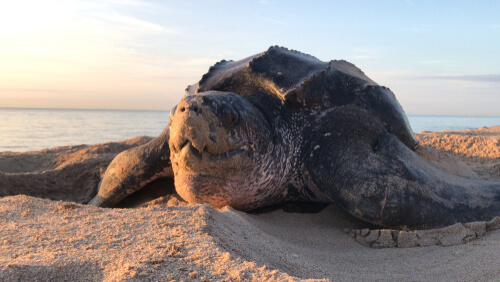
| Kingdom | Animalia |
| Phylum | Chordata |
| Class | Reptilia |
| Order | Testudines |
| Family | Dermochelyidae |
| Genus | Dermochelys |
| Species | D. coriacea |
| Niche | Nomadic marine turtle |
| Length | 6.5 ft (2 m) |
| Weight | 1,540 lb (700 kg) |
| Lifespan | 30-100 years |
| Social Structure | Solitary |
| Conservation Status | Vulnerable |
| Preferred Habitat | Temperate and tropical oceans |
| Average Clutch Size | 100 |
| Main Prey Species | Jellyfish |
| Predators | Humans, foxes, cats, dogs, sharks, fish |
The Basics
The leatherback sea turtle or is a large reptile of the family Dermochelyidae. It inhabits marine ecosystems and lays its eggs on lands in dramatic nesting events. The largest of all sea turtles and the fourth heaviest reptilian species in the world, the leatherback sea turtle can weigh up to 1,540 lb (700 kg).
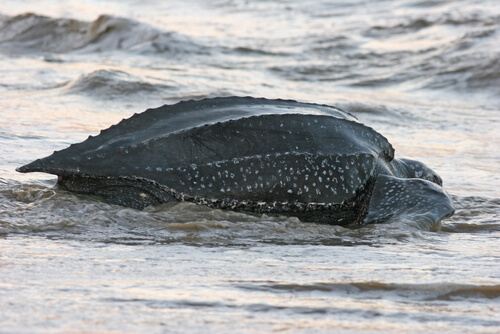
Description
The leatherback sea turtle is the largest of eight extant sea turtle species, weighing up to 1,540 lb (700 kg). They can grow up to 6.5 ft (2 m) long. Its name is derived from its shell which is a thick, leathery texture. It has long fore flippers and shorter hind flippers, and visible lateral lines down the length of its shell, which is dark green to black in appearance.
Distribution and Habitat
Leatherback sea turtles live in most of the world’s oceans and nest in tropical beaches in the Atlantic, Indian, and Pacific Oceans, although they were once much more abundant. Outside of the breeding season, they can be seen in temperate parts of the ocean as well such as the waters of Chile and New Zealand, for example.
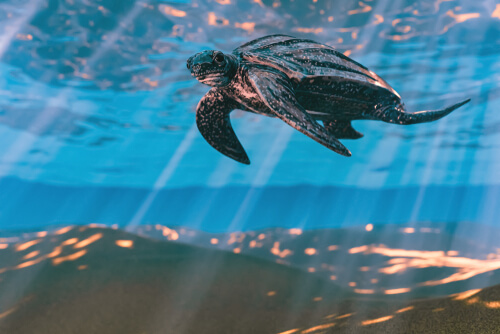
Diet and Predators
The leatherback sea turtle is unique among sea turtles in several ways, including their diet. They have a preference for jellyfish, snatching them out of the water column as they swim by. Leatherbacks will also eat other prey items such as small fish, mollusks, sea urchins, and various cephalopods.
Reproduction
Leatherback turtles travel great distances between their breeding grounds and feeding grounds. After mating at sea, females will haul themselves up on the beach to lay their eggs. Under the cover of nightfall, they will dig a hole in the sand and lay about eighty eggs before covering them again and returning to the sea.
New hatchlings are highly susceptible to predation and very few of the eggs laid by each female will survive to adulthood. Female hatchlings will roam the oceans until they reach sexual maturity at around 10 to 15 years of age. At this point, they will return to the same nesting area they were born in to breed again and restart the cycle anew. Males, in contrast, spend the rest of their lives at sea, living up to 100 years of age as a mostly solitary nomad.
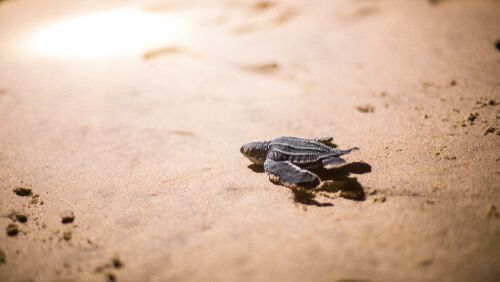
Conservation Status
Humans are a significant threat to leatherback sea turtles. In many areas where they nest, eggs are taken from nests for consumption or as false aphrodisiacs. Once grown, many turtles are killed by fishing lines and nets, often incidentally as bycatch. Plastic pollution and habitat destruction are further threats to the species.
In the 1980s, the worldwide population of leatherbacks was estimated at about 100,000 individuals. However, these numbers have reduced significantly since that time. For example, in 1986, 500 nests were counted on a beach in Mexico that by 1993 was host to only 50.
In the Atlantic ocean, the population of leatherback sea turtles appears to be stable following a decline from 1980s levels. However, the Pacific population is declining rapidly and have disappeared altogether in some areas such as Malaysia. These populations are Critically Endangered while the species as a whole is listed as “Vulnerable” by the IUCN Red List of Threatened Species.
Fun Facts about the Leatherback Sea Turtle!
The leatherback sea turtle is among the largest living reptiles and is a highly fascinating marine species to explore.
Plastic or Jelly
Human garbage is increasingly threatening marine ecosystems around the world, with plastic waste being one of the worst forms of pollution. As an unfortunate coincidence for leatherbacks, one of their favorite foods, jellyfish, tend to look quite similar to floating plastic debris such as shopping bags. Many turtles have been demonstrated to have ingested such items, with some individuals having been found with nearly 11 pounds of plastic in their stomachs. Without an end to the production of single-use plastics, these types of threats to marine species will only increase, potentially leading to their demise and the potential decay of entire ecosystems, many of which provide sustenance and income for humans.
The Race Car Turtle
All sea turtles travel great distances during their lifetime. The resistance created by the drag of water can make this difficult. Much like a boat is designed hydrodynamically to minimize drag from water resistance, so is the hydrodynamically efficient leatherback sea turtle. Their unique teardrop shape allows water to pass over their bodies with as little resistance as possible. This allows them to travel great of about 4,000 miles while migrating between their breeding grounds and their feeding sites. In addition to being able to travel long distances, they can reach a top speed of up to 22 mph (45 km/h) in the process.
The Cold Water Turtle
Although nests are located in tropical regions, leatherback sea turtles can be found in some temperate regions of this world. This is a unique trait to this species, with all other sea turtle species being confined to warmer waters. This range is made possible by the regulation of their body temperature warmer than the surrounding water due to a thick, oily, fat layer under their skin. Also, they have the ability to and their ability to restrict blood flow away from cold flippers, allowing their core organs to retain more heat than they would otherwise.
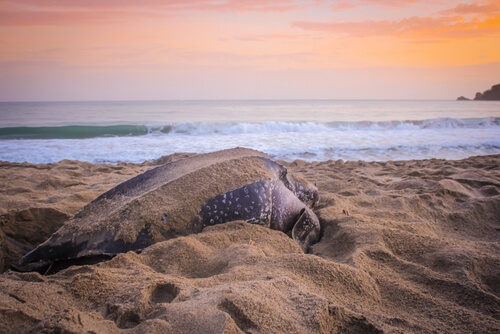
Sun Babies
Like other reptiles, the temperature inside of the nest of a sea turtle the nest determines the sex of the offspring. A mix of male and female hatchlings occurs when the nest temperature is approximately 85.1 degrees Fahrenheit, while higher temperatures produce females and cooler temperatures produce males. Thus, the population dynamics of the species year to year is highly dependent on the weather conditions that year as well as to long term climate trends. As anthropogenic global climate change continues to disrupt natural conditions around the world, this is yet another threat to the persistence of the leatherback sea turtle.
